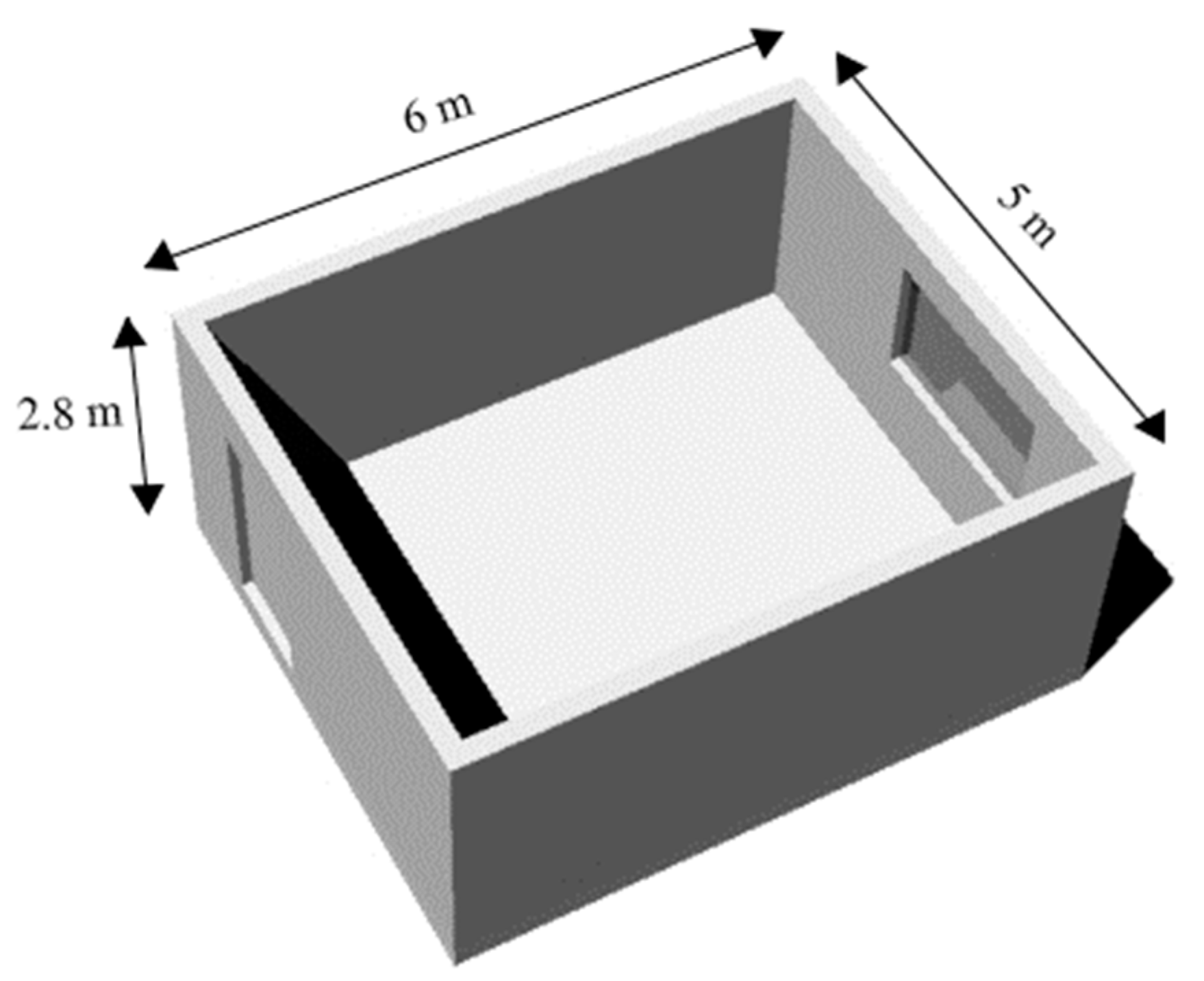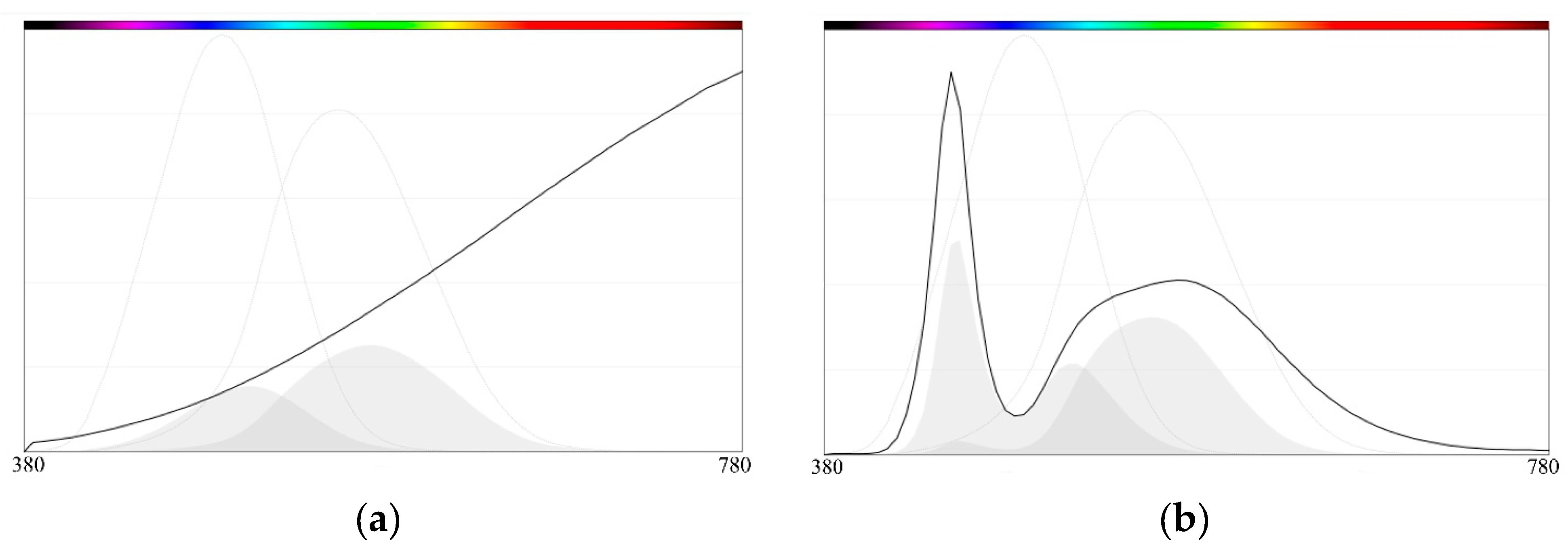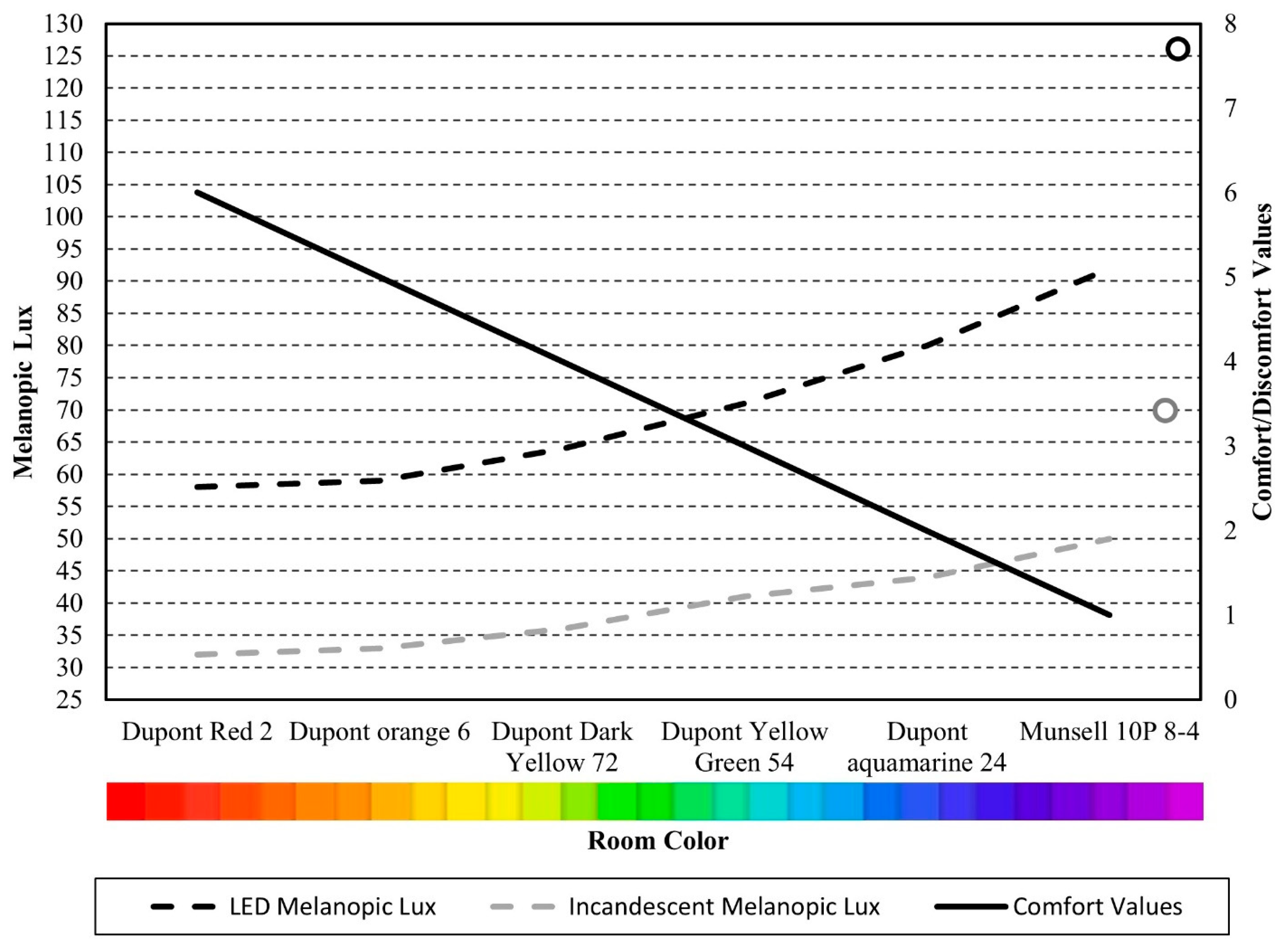Psychology or Physiology? Choosing the Right Color for Interior Spaces to Support Occupants’ Healthy Circadian Rhythm at Night
Abstract
1. Introduction
1.1. Impacts of Light and Color on Human Physiology
1.2. Impacts of Light and Color on Human Psychology
2. Method
2.1. Simulation Environment Setup
2.2. Phase One
2.3. Phase Two
3. Results
3.1. Results of the First Phase
3.2. Results of the Second Phase
3.3. Statistical Analysis
4. Discussions
4.1. Comparison to Comfort Measures
4.2. Intensity Comparison
5. Conclusions
6. Future Study
Author Contributions
Funding
Data Availability Statement
Conflicts of Interest
References
- Klepeis, N.E.; Nelson, W.C.; Ott, W.R.; Robinson, J.P.; Tsang, A.M.; Switzer, P.; Behar, J.V.; Hern, S.C.; Engelmann, W.H. The National Human Activity Pattern Survey (NHAPS): A resource for assessing exposure to environmental pollutants. J. Expo. Sci. Environ. Epidemiol. 2001, 11, 231–252. [Google Scholar] [CrossRef]
- Zolfaghari, Z.; Jones, J. Study of the Effect of Light Emitting Diode (LED) on the Optimum Window-to-Wall Ratio and Whole-Building Energy Consumption in Open Offices. Ph.D. Thesis, Virginia Tech, Blacksburg, VA, USA, 2022. [Google Scholar]
- Fisk, A.S.; Tam, S.K.E.; Brown, L.A.; Vyazovskiy, V.V.; Bannerman, D.M.; Peirson, S.N. Light and Cognition: Roles for Circadian Rhythms, Sleep, and Arousal. Front. Neurol. 2018, 9, 56. Available online: https://www.frontiersin.org/articles/10.3389/fneur.2018.00056 (accessed on 12 April 2023). [CrossRef]
- Santhi, N.; Ball, D.M. Chapter 2—Applications in sleep: How light affects sleep. In Progress in Brain Research; Parkin, B.L., Ed.; Real-World Applications in Cognitive Neuroscience; Elsevier: Amsterdam, The Netherlands, 2020; Volume 253, pp. 17–24. [Google Scholar] [CrossRef]
- Souman, J.L.; Tinga, A.M.; Pas, S.F.T.; van Ee, R.; Vlaskamp, B.N.S. Acute alerting effects of light: A systematic literature review. Behav. Brain Res. 2018, 337, 228–239. [Google Scholar] [CrossRef]
- Münch, M.; Wirz-Justice, A.; Brown, S.A.; Kantermann, T.; Martiny, K.; Stefani, O.; Vetter, C.; Wright, K.P., Jr.; Wulff, K.; Skene, D.J. The Role of Daylight for Humans: Gaps in Current Knowledge. Clocks Sleep 2020, 2, 61–85. [Google Scholar] [CrossRef]
- Schöllhorn, I.; Stefani, O.; Lucas, R.J.; Spitschan, M.; Slawik, H.C.; Cajochen, C. Melanopic irradiance defines the impact of evening display light on sleep latency, melatonin and alertness. Commun. Biol. 2023, 6, 228. [Google Scholar] [CrossRef]
- Davis, B. The Netflix Effect and Defining Binge-Watching. Undergraduate Research Posters. Available online: https://scholarscompass.vcu.edu/uresposters/190 (accessed on 1 January 2016).
- Wood, B.; Rea, M.S.; Plitnick, B.; Figueiro, M.G. Light level and duration of exposure determine the impact of self-luminous tablets on melatonin suppression. Appl. Ergon. 2013, 44, 237–240. [Google Scholar] [CrossRef] [PubMed]
- Tomassoni, R.; Galetta, G.; Treglia, E. Psychology of light: How light influences the health and psyche. Psychology 2015, 6, 1216. [Google Scholar] [CrossRef]
- Mahnke, F.H. Color, Environment, and Human Response: An Interdisciplinary Understanding of Color and Its Use as a Beneficial Element in the Design of the Architectural Environment; John Wiley & Sons: Hoboken, NJ, USA, 1996; 272p. [Google Scholar]
- Joyce, D.S.; Houser, K.W.; Peirson, S.N.; Zeitzer, J.M.; Zele, A.J. Melanopsin Vision: Sensation and Perception Through Intrinsically Photosensitive Retinal Ganglion Cells. Elements in Perception. December 2022. Available online: https://www.cambridge.org/core/elements/melanopsin-vision/25D01A0152E76F068B54E0CE351C62B8 (accessed on 12 April 2023).
- Brainard, G.C.; Sliney, D.; Hanifin, J.P.; Glickman, G.; Byrne, B.; Greeson, J.M.; Jasser, S.; Gerner, E.; Rollag, M.D. Sensitivity of the human circadian system to short-wavelength (420-nm) light. J. Biol. Rhythm. 2008, 23, 379–386. [Google Scholar] [CrossRef]
- Bailes, H.J.; Lucas, R.J. Human melanopsin forms a pigment maximally sensitive to blue light (λmax ≈ 479 nm) supporting activation of Gq/11 and Gi/o signalling cascades. Proc. R. Soc. B Biol. Sci. 2013, 280, 20122987. [Google Scholar]
- Brown, T.M.; Brainard, G.C.; Cajochen, C.; Czeisler, C.A.; Hanifin, J.P.; Lockley, S.W.; Lucas, R.J.; Münch, M.; O’Hagan, J.B.; Peirson, S.N.; et al. Recommendations for daytime, evening, and nighttime indoor light exposure to best support physiology, sleep, and wakefulness in healthy adults. PLOS Biol. 2022, 20, e3001571. [Google Scholar] [CrossRef] [PubMed]
- Meek, C.; Wymelenberg, K.V.D. Daylighting and Integrated Lighting Design; Routledge: London, UK, 2014; 116p. [Google Scholar]
- Konis, K. A novel circadian daylight metric for building design and evaluation. Build. Environ. 2017, 113, 22–38. [Google Scholar] [CrossRef]
- Serra-Negra, J.M.; Paiva, S.M.; Fulgêncio, L.B.; Chavez, B.A.; Lage, C.F.; Pordeus, I.A. Environmental factors, sleep duration, and sleep bruxism in Brazilian schoolchildren: A case-control study. Sleep Med. 2014, 15, 236–239. [Google Scholar] [CrossRef]
- Rautkylä, E.; Puolakka, M.; Tetri, E.; Halonen, L. Effects of correlated colour temperature and timing of light exposure on daytime alertness in lecture environments. J. Light Vis. Environ. 2010, 34, 59–68. [Google Scholar] [CrossRef]
- Rossi, M. Circadian Lighting Design in the LED Era; Springer: Berlin/Heidelberg, Germany, 2019; 277p. [Google Scholar]
- Sloane, P.D.; Williams, C.S.; Mitchell, C.M.; Preisser, J.S.; Wood, W.; Barrick, A.L.; Hickman, S.E.; Gill, K.S.; Connell, B.R.; Edinger, J.; et al. High-intensity environmental light in dementia: Effect on sleep and activity. J. Am. Geriatr. Soc. 2007, 55, 1524–1533. [Google Scholar] [CrossRef]
- Meesters, Y.; Winthorst, W.H.; Duijzer, W.B.; Hommes, V. The effects of low-intensity narrow-band blue-light treatment compared to bright white-light treatment in sub-syndromal seasonal affective disorder. BMC Psychiatry 2016, 16, 27. [Google Scholar] [CrossRef]
- Neale, C.; Griffiths, A.; Chalmin-Pui, L.S.; Mendu, S.; Boukhechba, M.; Roe, J. Color aesthetics: A transatlantic comparison of psychological and physiological impacts of warm and cool colors in garden landscapes. Wellbeing Space Soc. 2021, 2, 100038. [Google Scholar] [CrossRef]
- Persson, P.; Bondke Persson, A. Color in physiology. Acta Physiol. 2024, 240, e14182. [Google Scholar] [CrossRef]
- Fugate, J.M.B.; Franco, C.L. What color is your anger? Assessing color-emotion pairings in English speakers. Front. Psychol. 2019, 10, 206. [Google Scholar]
- Schaie, K.W. Scaling the association between colors and mood-tones. Am. J. Psychol. 1961, 74, 266–273. [Google Scholar] [CrossRef]
- Wexner, L.B. The degree to which colors (hues) are associated with mood-tones. J. Appl. Psychol. 1954, 38, 432. [Google Scholar] [CrossRef]
- Park, Y.; Guerin, D.A. Meaning and preference of interior color palettes among four cultures. J. Inter. Des. 2008, 28, 27–39. [Google Scholar] [CrossRef]
- Rapoport, A. Sacred Places, Sacred Occasions and Sacred Environments+ Design and Culture. Archit. Des. 1982, 52, 75–82. [Google Scholar]
- Manav, B. Color-emotion associations and color preferences: A case study for residences. Color Res. Appl. 2007, 32, 144–150. [Google Scholar] [CrossRef]
- Marani, F. Conquering SAD. 2019. Available online: https://aaltodoc.aalto.fi:443/handle/123456789/41413 (accessed on 24 December 2022).
- Siamionava, K.; Slevitch, L.; Tomas, S.R. Effects of spatial colors on guests’ perceptions of a hotel room. Int. J. Hosp. Manag. 2018, 70, 85–94. [Google Scholar] [CrossRef]
- Gulak, M.B. Gulak: Architectural Guidelines for State Psychiatric...—Google Scholar. 2006. Available online: https://scholar.google.com/scholar_lookup?title=Architectural%20guidelines%20for%20state%20psychiatric%20hospitals&publication_year=1991&author=M.B.%20Gulak (accessed on 24 December 2022).
- Küller, R.; Mikellides, B.; Janssens, J. Color, arousal, and performance—A comparison of three experiments. Color Res. Appl. 2009, 34, 141–152. [Google Scholar] [CrossRef]
- Brown, T.M. Melanopic illuminance defines the magnitude of human circadian light responses under a wide range of conditions. J. Pineal Res. 2020, 69, e12655. [Google Scholar] [CrossRef]
- Nowozin, C.; Wahnschaffe, A.; Rodenbeck, A.; de Zeeuw, J.; Hädel, S.; Kozakov, R.; Schöpp, H.; Münch, M.; Kunz, D. Applying Melanopic Lux to Measure Biological Light Effects on Melatonin Suppression and Subjective Sleepiness. Curr. Alzheimer Res. 2017, 14, 1042–1052. [Google Scholar] [CrossRef]
- Lucas, R.J.; Peirson, S.N.; Berson, D.M.; Brown, T.M.; Cooper, H.M.; Czeisler, C.A.; Figueiro, M.G.; Gamlin, P.D.; Lockley, S.W.; O’hAgan, J.B.; et al. Measuring and using light in the melanopsin age. Trends Neurosci. 2014, 37, 1–9. [Google Scholar] [CrossRef]
- CIE, S. 026/E: 2018; CIE System for Metrology of Optical Radiation for ipRGC-Influenced Responses to Light. CIE Central Bureau: Vienna, Austria, 2018.
- IWBI. WELL. International WELL Building Institute. Available online: https://www.wellcertified.com/ (accessed on 22 July 2023).
- Solemma. Adaptive Lighting for Alertness (ALFA). Available online: https://www.solemma.com/alfa (accessed on 31 May 2023).
- Boubekri, M. Daylighting, Architecture and Health: Building Design Strategies; Routledge: London, UK, 2008; 156p. [Google Scholar]
- Balakrishnan, P.; Jakubiec, J.A. Spectral Rendering with Daylight: A Comparison of Two Spectral Daylight Simulation Platforms. In Proceedings of the BS2019, Rome, Italy, 2–4 September 2019. [Google Scholar]
- Elsayedand, N.; Rakha, T. A framework to simulate the non-visual effects of daylight on the cognitive health of mild cognitive impairment (mci) people. In Proceedings of the ASHRAE Topical Conference Proceedings, Virtual, 29 September–1 October 2020; American Society of Heating, Refrigeration and Air Conditioning Engineers, Inc.: Peachtree Corners, GA, USA, 2020; pp. 119–129. [Google Scholar]
- Saiedlue, S.; Amirazar, A.; Hu, J.; Place, W. Assessing circadian stimulus potential of lighting systems in office buildings by simulations. In Proceedings of the ARCC Conference Repository, Toronto, Canada, 29 May–1 June 2019. [Google Scholar]
- DiLaura, D.L. The Lighting Handbook: Reference and Application; Illuminating Engineering Society of North America: New York, NY, USA, 2011; 1068p. [Google Scholar]
- Valdez, P.; Mehrabian, A. Effects of color on emotions. J. Exp. Psychol. Gen. 1994, 123, 394. [Google Scholar] [CrossRef]
- Sutton, T.; Whelan, B.M. The Complete Color Harmony: Expert Color Information for Professional Color Results; Rockport Publishers: Gloucester, MA, USA, 2004; 218p. [Google Scholar]
- Hupka, R.B.; Zaleski, Z.; Otto, J.; Reidl, L.; Tarabrina, N.V. The colors of anger, envy, fear, and jealousy: A cross-cultural study. J. Cross-Cult. Psychol. 1997, 28, 156–171. [Google Scholar] [CrossRef]





| Color Name | Fixed or Variable | Type | Radiance | L | a | b | m/p |
|---|---|---|---|---|---|---|---|
| Light Gray Stone Tiles (Floor) | Fixed | Opaque | Plastic | 59.81 | −0.51 | 1.97 | 0.98 |
| Door and Window Frame | Fixed | Opaque | Plastic | 26.26 | 5.03 | 3.15 | 0.86 |
| Window Glass: Double IGU Green Tvis 32% | Fixed | Transparent | 1.09 | ||||
| Dupont Red 2 | Variable | Opaque | Plastic | 34.0727 | 57.9253 | 48.0845 | 0.09 |
| Dupont Orange 6 | Variable | Opaque | Plastic | 48.6471 | 55.1909 | 58.5206 | 0.14 |
| Dupont Aquamarine 24 | Variable | Opaque | Plastic | 56.6106 | −16.7631 | −31.7029 | 2.06 |
| Dupont Dark Yellow 72 | Variable | Opaque | Plastic | 75.8242 | 15.1119 | 78.9902 | 0.20 |
| Dupont Yellow Green 54 | Variable | Opaque | Plastic | 73.103 | −23.7358 | 49.311 | 0.68 |
| Munsell 10P 8/4 (Light Blue) | Variable | Opaque | Plastic | 80.825 | 6.0705 | −15.238 | 1.04 |
| Macbeth White | Variable | Opaque | Plastic | 96.682 | −0.6138 | 1.7525 | 0.99 |
| Room Color | Light Source | Photopic Lux (P1) | Melanopic Lux (P1) | Photopic Lux (P2) | Melanopic Lux (P2) | Horizontal Workplane Illuminance (P1) | Horizontal Workplane Illuminance (P2) | |
|---|---|---|---|---|---|---|---|---|
| Dupont Red 2 | LED 0.87 | 71 | 58 | 40 | 33 | 240 | 130 | |
| Dupont Red 2 | Incandescent 0.48 | 75 | 32 | 43 | 19 | 243 | 131 | |
| Dupont Orange 6 | LED 0.87 | 78 | 59 | 44 | 34 | 245 | 132 | |
| Dupont Orange 6 | Incandescent 0.48 | 84 | 33 | 47 | 19 | 250 | 134 | |
| Dupont Dark Yellow 72 | LED 0.87 | 103 | 64 | 56 | 36 | 268 | 143 | |
| Dupont Dark Yellow 72 | Incandescent 0.48 | 109 | 36 | 59 | 21 | 273 | 145 | |
| Dupont Yellow Green 54 | LED 0.87 | 93 | 71 | 52 | 40 | 256 | 137 | |
| Dupont Yellow Green 54 | Incandescent 0.48 | 91 | 41 | 51 | 23 | 255 | 137 | |
| Dupont Aquamarine 24 | LED 0.87 | 77 | 80 | 44 | 44 | 244 | 132 | |
| Dupont Aquamarine 24 | Incandescent 0.48 | 77 | 44 | 43 | 25 | 243 | 131 | |
| Munsell 10P 8/4 | LED 0.87 | 103 | 92 | 56 | 50 | 266 | 142 | |
| Munsell 10P 8/4 | Incandescent 0.48 | 105 | 50 | 57 | 27 | 268 | 143 | |
| Macbeth White | LED 0.87 | 149 | 126 | 78 | 66 | 314 | 154 | |
| Macbeth White | Incandescent 0.48 | 148 | 70 | 78 | 37 | 313 | 165 | |
| Ranking | Color | Associated Emotions |
|---|---|---|
| 1 | Violet | Dignified and stately [27] |
| 2 | Blue | Tender, soothing, calm, peaceful, and serene [27] Peaceful, comfortable, and soothing [26] Peaceful and releasing [30] Calmness [25] High pleasure [46] |
| 3 | Green | Envy and disgust [25] High pleasure [46] Connected to nature and rebirth [47] |
| 4 | Yellow | Cheerful and joyful [27] Happiness [25] |
| 5 | Orange | Disturbing [27] Stimulating and cheerful [26] Low pleasure [46] |
| 6 | Red | Stimulating and exciting [27] Anger and fear [25,48] Striking and depressive [30] Low pleasure [46] |
Disclaimer/Publisher’s Note: The statements, opinions and data contained in all publications are solely those of the individual author(s) and contributor(s) and not of MDPI and/or the editor(s). MDPI and/or the editor(s) disclaim responsibility for any injury to people or property resulting from any ideas, methods, instructions or products referred to in the content. |
© 2025 by the authors. Licensee MDPI, Basel, Switzerland. This article is an open access article distributed under the terms and conditions of the Creative Commons Attribution (CC BY) license (https://creativecommons.org/licenses/by/4.0/).
Share and Cite
Jalali, M.S.; Gibbons, R.B.; Jones, J.R. Psychology or Physiology? Choosing the Right Color for Interior Spaces to Support Occupants’ Healthy Circadian Rhythm at Night. Buildings 2025, 15, 2665. https://doi.org/10.3390/buildings15152665
Jalali MS, Gibbons RB, Jones JR. Psychology or Physiology? Choosing the Right Color for Interior Spaces to Support Occupants’ Healthy Circadian Rhythm at Night. Buildings. 2025; 15(15):2665. https://doi.org/10.3390/buildings15152665
Chicago/Turabian StyleJalali, Mansoureh Sadat, Ronald B. Gibbons, and James R. Jones. 2025. "Psychology or Physiology? Choosing the Right Color for Interior Spaces to Support Occupants’ Healthy Circadian Rhythm at Night" Buildings 15, no. 15: 2665. https://doi.org/10.3390/buildings15152665
APA StyleJalali, M. S., Gibbons, R. B., & Jones, J. R. (2025). Psychology or Physiology? Choosing the Right Color for Interior Spaces to Support Occupants’ Healthy Circadian Rhythm at Night. Buildings, 15(15), 2665. https://doi.org/10.3390/buildings15152665






